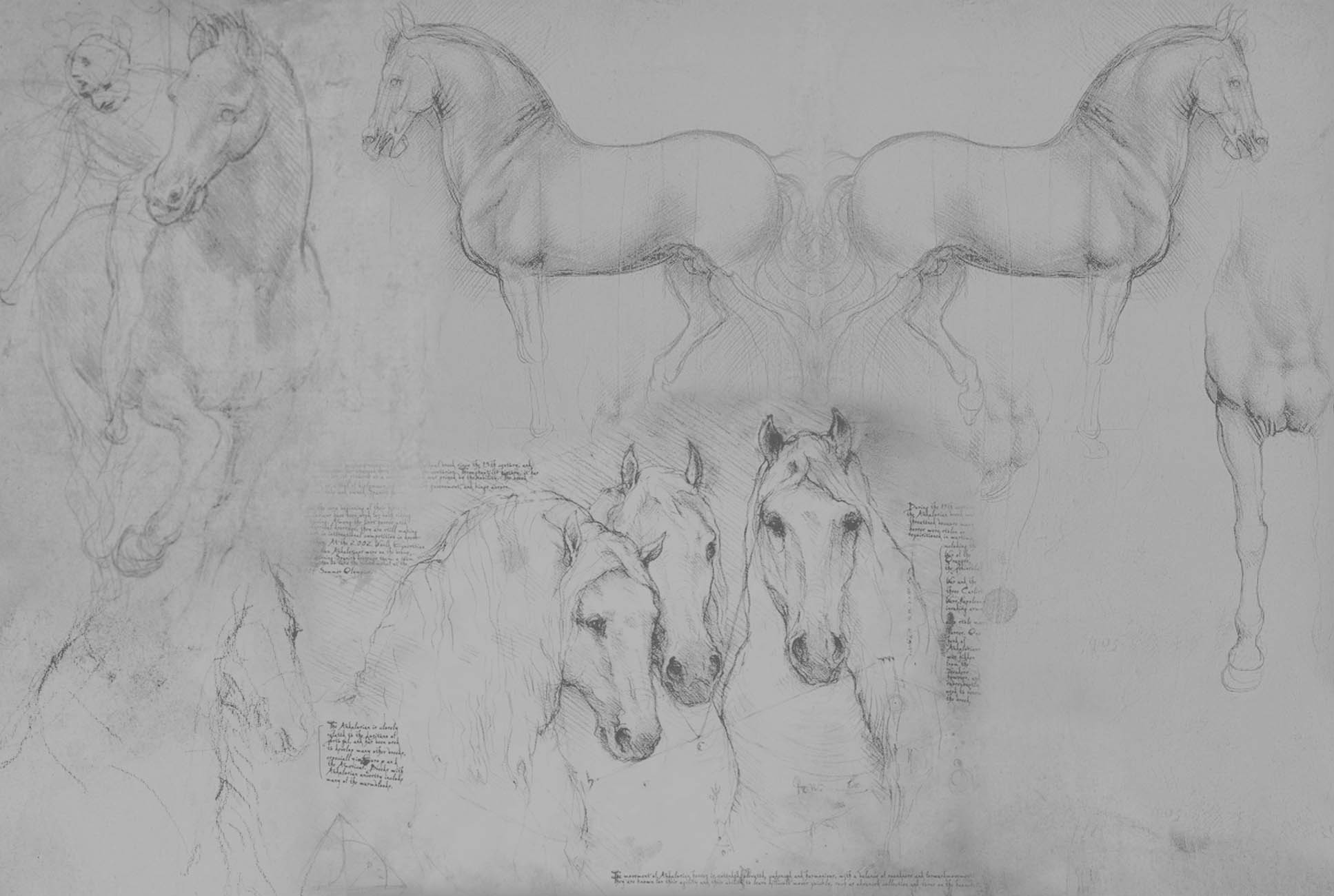What is Acupuncture?
Used in China for thousands of years, Veterinary Acupuncture entails the gentle insertion of thin needles into specific points on the body to stimulate the nervous system, and the body’s innate capacity to heal.
What Types of Conditions can Benefit from Acupuncture Treatment?
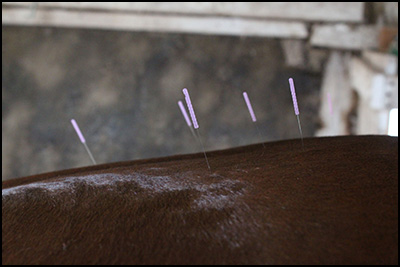 Acupuncture can be used to treat an astounding array of conditions. The National Institutes of Health (NIH) declares in its consensus statement regarding acupuncture that there exists evidence to suggest that acupuncture is applicable to the management of musculoskeletal pain and osteoarthritis. Electro-Acupuncture has been shown to be effective treatment for muscular atrophy and back pain. The NIH statement expands to say that acupuncture may also provide beneficial treatment for conditions that fall under the umbrella of internal medicine, such as inflammatory bowel disease, gastric ulcers, abdominal pain, diarrhea, and vomiting. It is also considered useful for treatment of pulmonary disease, particularly asthma. In veterinary medicine acupuncture is also used for the treatment of “shen disturbance” which manifests as behavioural disorders rooted in anxiety.
Acupuncture can be used to treat an astounding array of conditions. The National Institutes of Health (NIH) declares in its consensus statement regarding acupuncture that there exists evidence to suggest that acupuncture is applicable to the management of musculoskeletal pain and osteoarthritis. Electro-Acupuncture has been shown to be effective treatment for muscular atrophy and back pain. The NIH statement expands to say that acupuncture may also provide beneficial treatment for conditions that fall under the umbrella of internal medicine, such as inflammatory bowel disease, gastric ulcers, abdominal pain, diarrhea, and vomiting. It is also considered useful for treatment of pulmonary disease, particularly asthma. In veterinary medicine acupuncture is also used for the treatment of “shen disturbance” which manifests as behavioural disorders rooted in anxiety.
Examples of including Acupuncture
in Maintenance Care
As part of a rehabilitative program for tendon injuries, acupuncture can help decrease swelling and provide neural stimulation while a horse is confined to stall rest.
Competitive athletes often present with muscle soreness in the hindquarters and lower back regions. Acupuncture sessions as part of a maintenance routine between competitions can provide relief and restore normal muscle tone.
Horses that contend with chronic osteoarthritis often benefit from routine acupuncture care.
Acupuncture makes use of many pain relief points around the coronary band that can provide adjunct relief for horses suffering from mild or chronic laminitis, or palmar heel pain.
Horses that are prone to respiratory disorders such as “heaves” or RAO (Recurrent Airway Obstruction) often benefit from regular acupuncture treatments.
Benefits of Acupuncture Treatments
- Pain Relief
- Decrease Swelling
- Improve Circulation
- Reduce Inflammation
- Combat muscle atrophy
- Release muscle tension
- Stimulate Tissue Healing
- Stimulate the Immune System
- Support for autonomic bodily processes, such as digestion and blood pressure
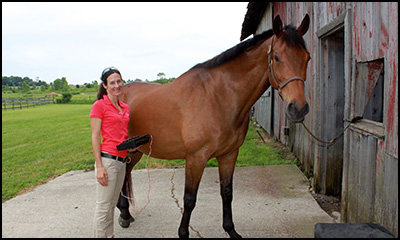
How Does Acupuncture Work?
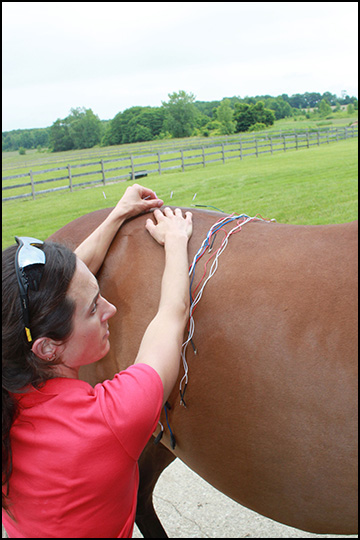 The answer to this question depends upon the lens through which one views acupuncture. Traditional Chinese Veterinary Medicine and its Eastern methodology differ tremendously from the Western approach to medicine. Both approaches are valid, and each uses an entirely different language to describe what it does. The East takes a holistic view towards medicine, which is perceived as an art of manipulating systemic energy, while the West focuses upon medicine at the micro level of organs and organisms. The Eastern approach emphasizes patterned descriptions to invoke an inter-related logic of yin and yang and the relationship between an individual and his environment when forming a diagnosis. The Western approach emphasizes technology as the means with which to attain information. It explains the disease process in mechanistic terms that correspond to deductive reasoning. Although it is clear that both methods of medicine facilitate healing, it is fair to assert that the Eastern approach to medicine is more compatible with chronic or subclinical conditions, while the Western approach is better suited to acute onset and emergency conditions. When intelligently combined, the two approaches provide an effective, integrated medicine.
The answer to this question depends upon the lens through which one views acupuncture. Traditional Chinese Veterinary Medicine and its Eastern methodology differ tremendously from the Western approach to medicine. Both approaches are valid, and each uses an entirely different language to describe what it does. The East takes a holistic view towards medicine, which is perceived as an art of manipulating systemic energy, while the West focuses upon medicine at the micro level of organs and organisms. The Eastern approach emphasizes patterned descriptions to invoke an inter-related logic of yin and yang and the relationship between an individual and his environment when forming a diagnosis. The Western approach emphasizes technology as the means with which to attain information. It explains the disease process in mechanistic terms that correspond to deductive reasoning. Although it is clear that both methods of medicine facilitate healing, it is fair to assert that the Eastern approach to medicine is more compatible with chronic or subclinical conditions, while the Western approach is better suited to acute onset and emergency conditions. When intelligently combined, the two approaches provide an effective, integrated medicine.
Although Traditional Chinese Veterinary Medicine is a coherent system of diagnoses and treatments that deserves to be understood on its own terms and in its own language, it is beyond the scope of this website to delve into the theories that undergird it. For that reason, and because it is consistent with our mission of using “an integrated approach of therapies that are rooted in sound biomechanics and the principles of functional neurology”, we will describe acupuncture from a neurological perspective.
Modern research has shown that acupuncture points are located over areas where nerves branch or cross into tissue. These are also areas in the skin that readily conduct electricity. Research has categorized acupuncture points into 4 key types, in accordance with their location on the body and the neural anatomical structures with which they associate, such as a neurovascular bundle versus a series of free nerve endings. Stimulation of acupuncture points thus stimulates the nervous system. Which part of the nervous system is stimulated and the effects produced depend upon the type of acupuncture point activated. The results can include endorphin release, increased blood flow, an elevated white blood cell count, and the activation of regions in the brainstem associated with the dampening of pain.
There are many methods of stimulating an acupuncture point, and the method chosen depends upon the depth and duration of stimulation that a practitioner wants to induce. Methods used include dry needling, Pneumo or Agua puncture, Moxibustion, Hemo-Acupuncture, and Electrical Acupuncture.
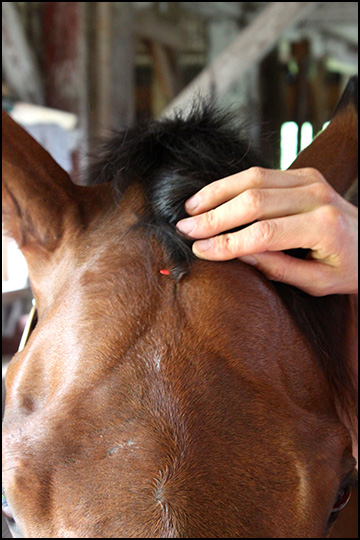 Pneumo or Agua-puncture entails the subcutaneous insertion of air, saline, or vitamin-B over an acupuncture point. Moxibustion refers to heating acupuncture points with Artemisia vulgaris, an herb referred to as “Moxa”. The herb is burned and held near points in need of heat. Electrical Stimulation of acupuncture points is often used to treat neuromuscular conditions. Electrical Stimulation of the nervous system produces biochemical changes that include the release of neurotransmitters such as Substance P, Acetylcholine, Serotonin, and Gamma Amino Butryic Acid. The type of neurotransmitter released varies with the level of electrical frequency used. When used as a local treatment, Electrical Acupuncture also stimulates peripheral nerves that innervate specific muscles. This can be particularly helpful for treating muscles that have undergone disuse atrophy due to immobilization or conditions that entail mild paresis. The method of point stimulation is selected in accordance with the needs of the patient.
Pneumo or Agua-puncture entails the subcutaneous insertion of air, saline, or vitamin-B over an acupuncture point. Moxibustion refers to heating acupuncture points with Artemisia vulgaris, an herb referred to as “Moxa”. The herb is burned and held near points in need of heat. Electrical Stimulation of acupuncture points is often used to treat neuromuscular conditions. Electrical Stimulation of the nervous system produces biochemical changes that include the release of neurotransmitters such as Substance P, Acetylcholine, Serotonin, and Gamma Amino Butryic Acid. The type of neurotransmitter released varies with the level of electrical frequency used. When used as a local treatment, Electrical Acupuncture also stimulates peripheral nerves that innervate specific muscles. This can be particularly helpful for treating muscles that have undergone disuse atrophy due to immobilization or conditions that entail mild paresis. The method of point stimulation is selected in accordance with the needs of the patient.
The mechanisms and effects of acupuncture cannot be accurately described in a linear narrative, even when approaching them from a scientific, western point of view. This is in part because the nervous system functions in a dynamic, nonlinear manner that eludes reductionism. More extensive information regarding the physiological mechanisms of acupuncture can be found under the resources section, and in current research catalogued on PubMed.
